Project(阅读理解部分)教师版
- 格式:docx
- 大小:10.77 KB
- 文档页数:3
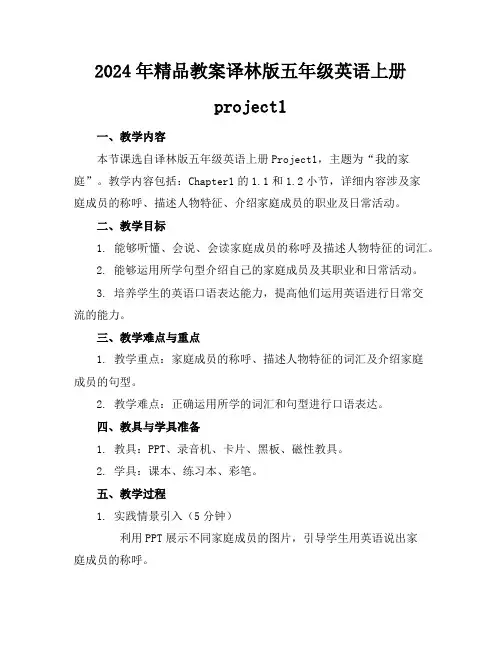
2024年精品教案译林版五年级英语上册project1一、教学内容本节课选自译林版五年级英语上册Project1,主题为“我的家庭”。
教学内容包括:Chapter1的1.1和1.2小节,详细内容涉及家庭成员的称呼、描述人物特征、介绍家庭成员的职业及日常活动。
二、教学目标1. 能够听懂、会说、会读家庭成员的称呼及描述人物特征的词汇。
2. 能够运用所学句型介绍自己的家庭成员及其职业和日常活动。
3. 培养学生的英语口语表达能力,提高他们运用英语进行日常交流的能力。
三、教学难点与重点1. 教学重点:家庭成员的称呼、描述人物特征的词汇及介绍家庭成员的句型。
2. 教学难点:正确运用所学的词汇和句型进行口语表达。
四、教具与学具准备1. 教具:PPT、录音机、卡片、黑板、磁性教具。
2. 学具:课本、练习本、彩笔。
五、教学过程1. 实践情景引入(5分钟)利用PPT展示不同家庭成员的图片,引导学生用英语说出家庭成员的称呼。
组织学生进行小组活动,互相介绍自己的家庭成员。
2. 例题讲解(15分钟)通过PPT展示例题,引导学生学习描述人物特征的词汇。
讲解介绍家庭成员的句型,并进行示范。
3. 随堂练习(10分钟)让学生根据所学的词汇和句型,介绍自己的家庭成员,并进行小组分享。
教师挑选部分学生进行展示,给予评价和指导。
4. 巩固拓展(15分钟)利用磁性教具,进行家庭成员称呼和人物特征词汇的练习。
学生自主设计对话,介绍家庭成员的职业和日常活动。
学生分享学习心得,提出疑问,教师解答。
六、板书设计1. 家庭成员称呼2. 描述人物特征词汇3. 介绍家庭成员句型七、作业设计1. 作业题目:用英语介绍自己的家庭成员,包括称呼、特征、职业和日常活动。
2. 答案示例:My family has six members. They are my father, mother, older brother, older sister, younger brother and me. Myfather is a doctor. He works in a hospital. My mother is a teacher. She teaches English in a primary school. My olderbrother is a student. He is in high school. My older sisteris a dancer. She performs on stage every weekend. My younger brother is in kindergarten. He likes playing with toys.八、课后反思及拓展延伸1. 反思:关注学生的学习情况,了解他们在口语表达中的困难和问题,及时给予指导和帮助。
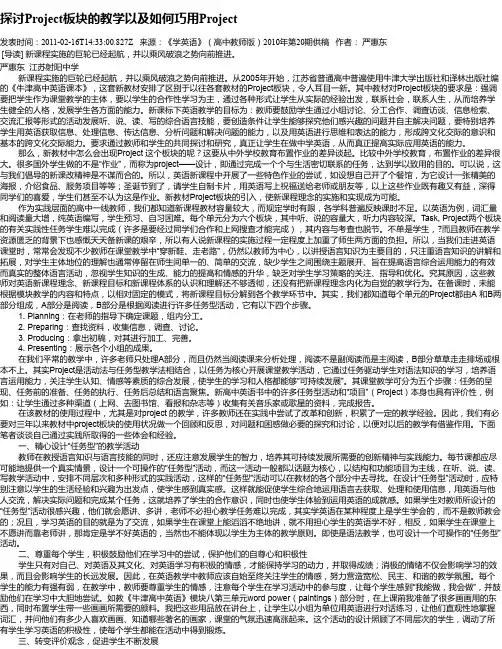
探讨Project板块的教学以及如何巧用Project发表时间:2011-02-16T14:33:00.827Z 来源:《学英语》(高中教师版)2010年第20期供稿作者:严惠东[导读] 新课程实施的巨轮已经起航,并以乘风破浪之势向前推进。
严惠东江苏射阳中学新课程实施的巨轮已经起航,并以乘风破浪之势向前推进。
从2005年开始,江苏省普通高中普遍使用牛津大学出版社和译林出版社编的《牛津高中英语课本》,这套新教材安排了区别于以往各套教材的Project板块,令人耳目一新。
其中教材对Project板块的要求是:强调要把学生作为课堂教学的主体,要以学生的合作性学习为主,通过各种形式让学生从实际的经验出发,联系社会,联系人生,从而培养学生健全的人格,发展学生各方面的能力。
新课标下英语教学的目标为:教师要鼓励学生通过小组讨论、分工合作、调查访谈、信息检索、交流汇报等形式的活动发展听、说、读、写的综合语言技能,要创造条件让学生能够探究他们感兴趣的问题并自主解决问题,要特别培养学生用英语获取信息、处理信息、传达信息、分析问题和解决问题的能力,以及用英语进行思维和表达的能力,形成跨文化交际的意识和基本的跨文化交际能力。
要求通过教师和学生的共同探讨和研究,真正让学生在做中学英语,从而真正提高实际应用英语的能力。
那么,新教材中怎么会出现Project 这个板块的呢?这要从中外学校教育布置作业的差异谈起。
比较中外学校教育,布置作业的差异很大。
很多国外学生做的不是“作业”,而称为project——设计,即通过完成一个个与生活密切联系的任务,达到学以致用的目的。
可以说,这与我们倡导的新课改精神是不谋而合的。
所以,英语新课程中开展了一些特色作业的尝试,如设想自己开了个餐馆,为它设计一张精美的海报,介绍食品、服务项目等等;圣诞节到了,请学生自制卡片,用英语写上祝福送给老师或朋友等,以上这些作业既有趣又有益,深得同学们的喜爱,学生们甚至不认为这是作业。
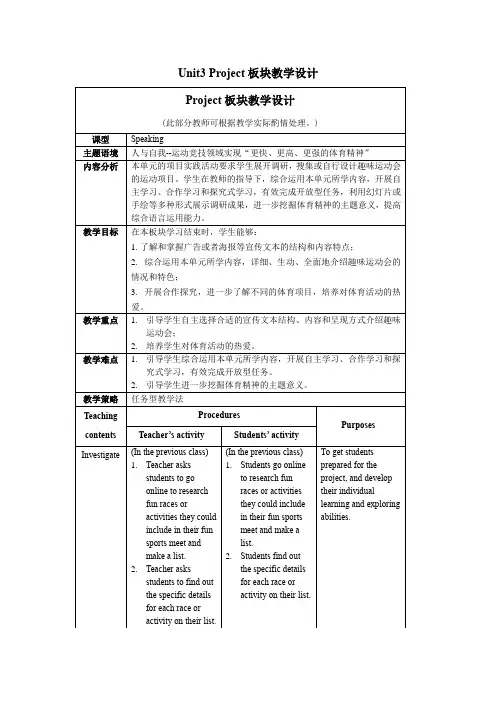
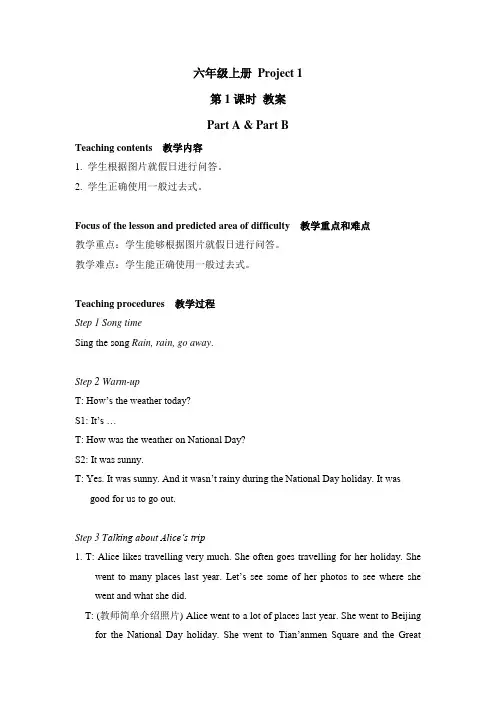
六年级上册Project 1第1课时教案Part A & Part BTeaching contents 教学内容1. 学生根据图片就假日进行问答。
2. 学生正确使用一般过去式。
Focus of the lesson and predicted area of difficulty 教学重点和难点教学重点:学生能够根据图片就假日进行问答。
教学难点:学生能正确使用一般过去式。
Teaching procedures 教学过程Step 1 Song timeSing the song Rain, rain, go away.Step 2 Warm-upT: How’s the weather today?S1: It’s…T: How was the weather on National Day?S2: It was sunny.T: Yes. It was sunny. And it wasn’t rainy during the National Day holiday. It was good for us to go out.Step 3 T alking about Alice’s trip1. T: Alice likes travelling very much. She often goes travelling for her holiday. Shewent to many places last year. Let’s see some of her photos to see where she went and what she did.T: (教师简单介绍照片) Alice went to a lot of places last year. She went to Beijing for the National Day holiday. She went to Tian’anmen Square and the GreatWall. “China is really great!” She said to me after she came back. For winter holiday, Alice went to Sanya. It was very hot there in winter. It was sunny and the sky was blue. She went swimming and played a lot on the beach. She had a good time.T: For her summer holiday, Alice went to Hong Kong in July. She went to Disneyland and had great fun there. She liked it very much. She also went to London with her family. She saw Big Ben there. How happy Alice was!(Students enjoy the photos on which there are the names of the holidays and the names of the places.)2. Try to answer following questions (PPT呈现)T: Where did Alice go last year?S3: She went to Beijing, Sanya, Hong Kong and London.T: What did she do in Beijing?S4: She visited Tian’anmen Square and the Great Wall.T: Did she go swimming in Sanya?S5: Yes, she did. She also played a lot on the beach.T: Did she have great fun in Disneyland?S6: Yes, she did.T: What did she see in London?S7: She saw Big Ben there.【设计意图:给学生展示Alice的旅行照片、带着任务聆听老师的介绍,对动词过去式、天气描述等内容进行巩固性输入,同时唤起学生对自己的假期旅行的回忆,产生想和同学分享的欲望。
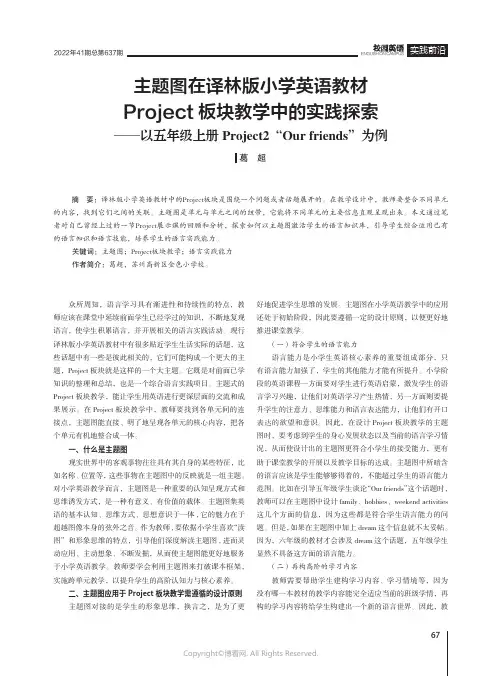
ENGLISH ON CAMPUS2022年41期总第637期主题图在译林版小学英语教材Project板块教学中的实践探索——以五年级上册Project2“Our friends”为例摘 要:译林版小学英语教材中的Project板块是围绕一个问题或者话题展开的。
在教学设计中,教师要整合不同单元的内容,找到它们之间的关联。
主题图是单元与单元之间的纽带,它能将不同单元的主要信息直观呈现出来。
本文通过笔者对自己曾经上过的一节Project展示课的回顾和分析,探索如何以主题图激活学生的语言知识库,引导学生综合运用已有的语言知识和语言技能,培养学生的语言实践能力。
关键词:主题图;Project板块教学;语言实践能力作者简介:葛超,苏州高新区金色小学校。
众所周知,语言学习具有渐进性和持续性的特点,教师应该在课堂中延续前面学生已经学过的知识,不断地复现语言,使学生积累语言,并开展相关的语言实践活动。
现行译林版小学英语教材中有很多贴近学生生活实际的话题,这些话题中有一些是彼此相关的,它们可能构成一个更大的主题,Project板块就是这样的一个大主题。
它既是对前面已学知识的整理和总结,也是一个综合语言实践项目。
主题式的Project板块教学,能让学生用英语进行更深层面的交流和成果展示。
在Project板块教学中,教师要找到各单元间的连接点,主题图能直接、明了地呈现各单元的核心内容,把各个单元有机地整合成一体。
一、什么是主题图现实世界中的客观事物往往具有其自身的某些特征,比如名称、位置等,这些事物在主题图中的反映就是一组主题。
对小学英语教学而言,主题图是一种重要的认知呈现方式和思维诱发方式,是一种有意义、有价值的载体。
主题图集英语的基本认知、思维方式、思想意识于一体,它的魅力在于超越图像本身的弦外之音。
作为教师,要依据小学生喜欢“读图”和形象思维的特点,引导他们深度解读主题图,进而灵动应用、主动想象、不断发掘,从而使主题图能更好地服务于小学英语教学。

2024浙江高考真题英语(1月)第一部分听力(共两节,满分30分)做题时,先将答案标在试卷上。
录音内容结束后,你将有两分钟的时间将试卷上的答案转涂到答题纸上。
第一节(共5小题:每小题1.5分,满分7.5分)听下面5段对话。
每段对话后有一个小题,从题中所给的A、B、C三个选项中选出最佳选项。
听完每段对话后,你都有10秒钟的时间来回答有关小题和阅读下一小题。
每段对话仅读一遍。
例:How much is the shin?A. £19.15.B. £9.18.C. £9.15.答案是C。
1. What does the man do?A. A computer technician.B. A hotel receptionist.C. A shop assistant.2. Where does the conversation take place?A. At the grocer’s.B. At the tailor’s.C. At the cleaner’s.3. How did the speaker come to Seattle?A. By plane.B. By car.C. By train.4. What will the speakers have for dinner today?A. Fried rice.B. Noodles.C. Steak.5. How is Sophie feeling now?A. Confused.B. Worried.C. Disappointed.第二节(共15小题:每小题1.5分,满分22.5分)听下面5段对话或读白。
每段对话或独白后有几个小题,从题中所给的A、B、C三个选项中选出最佳选项,并标在试卷的相应位置。
听每段对话或独白前,你将有时间阅读各个小题,每小题5秒钟;听完后,各小题将给出5秒钟的作答时间。
每段对话或独白读两遍。
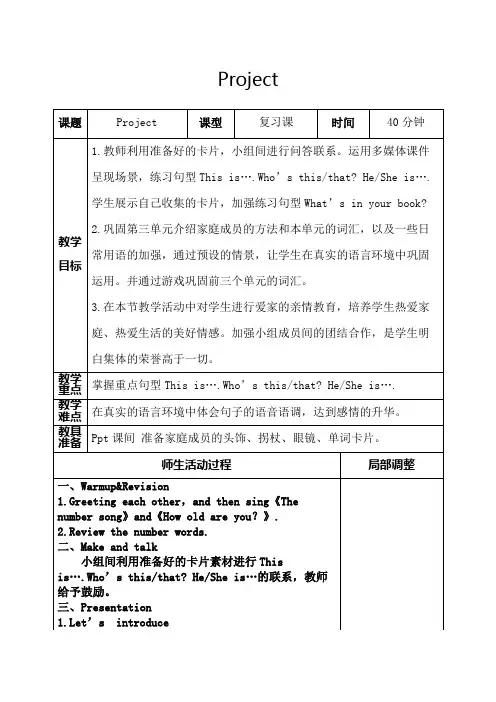

2021普通高等学校招生全国统一考试(北京卷)英语考生须知:1.本试卷满分100分。
2.在试卷和答题卡上准确填写学校、班级、姓名和学号。
3.试题答案一律填写在答题卡上,在试卷上作答无效。
4.在答题卡上,选择题须用2B铅笔将选中项涂黑涂满,其他试题用黑色字迹签字笔作答。
5.考试结束时,将本试卷、答题卡一并交回。
第一部分知识运用(共两节,30 分)第一节(共10 小题;每小题1.5 分,共15 分)阅读下面短文,掌握其大意,从每题所给的A、B、C、D 四个选项中,选出最佳选项,并在答题卡上将该项涂黑。
Recently, I took a trip home by train. I got a seat opposite a middle-aged man with sharp eyes, who kept 1 a young woman in a window seat with a little boy on her lap. The woman’s eye fell on the man’s face, and she immediately looked down and 2 her scarf.As the night wore on, people began to close their eyes, but the seats were so uncomfortable that only a very heavy sleeper could manage to get any 3 . The woman looked over at the man. He was still staring at her. She looked back at him with fire in her eyes. I was beginning to get 4 , too.The train moved on. The little boy was 5 awake on his mother’s lap, but the woman dropped off to sleep. A moment later, he began to 6 the half-open window—one leg went over it. The man jumped up and 7 the child just before he fell out.The 8 woke up the woman. She seemed to be in 9 , and then reality dawned (显现). “Your child has been looking for an opportunity to climb out of the window,” the man said as he gave the child back to her. “So I have been watching the whole time.” The woman was 10 , and so was I.1.A.guiding B.bothering C.watching D.monitoring2.A.adjusted B.changed C.packed D.waved3.A.air B.joy C.space D.rest4.A.nervous B.embarrassed C.angry D.disappointed5.A.almost B.still C.hardly D.even6.A.drag B.climb C.knock D.push7.A.grabbed B.rocked C.touched D.picked8.A.alarm B.quarrel C.risk D.noise9.A.sorrow B.relief C.panic D.pain10.A.astonished B.confused C.concerned D.inspired第二节(共10 小题;每小题1.5 分,共15 分)阅读下列短文,根据短文内容填空。
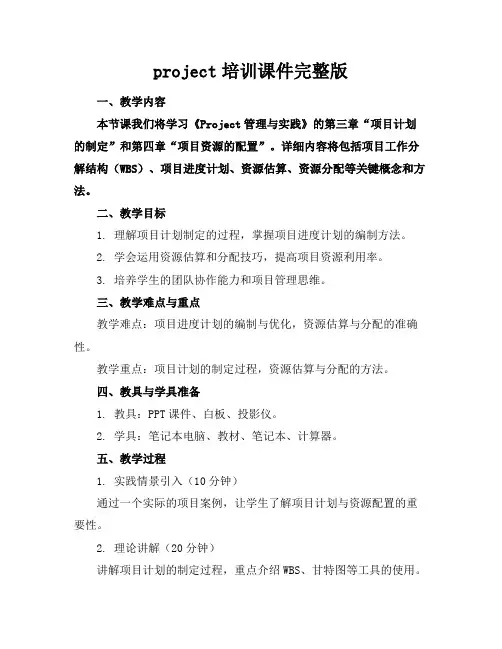
project培训课件完整版一、教学内容本节课我们将学习《Project管理与实践》的第三章“项目计划的制定”和第四章“项目资源的配置”。
详细内容将包括项目工作分解结构(WBS)、项目进度计划、资源估算、资源分配等关键概念和方法。
二、教学目标1. 理解项目计划制定的过程,掌握项目进度计划的编制方法。
2. 学会运用资源估算和分配技巧,提高项目资源利用率。
3. 培养学生的团队协作能力和项目管理思维。
三、教学难点与重点教学难点:项目进度计划的编制与优化,资源估算与分配的准确性。
教学重点:项目计划的制定过程,资源估算与分配的方法。
四、教具与学具准备1. 教具:PPT课件、白板、投影仪。
2. 学具:笔记本电脑、教材、笔记本、计算器。
五、教学过程1. 实践情景引入(10分钟)通过一个实际的项目案例,让学生了解项目计划与资源配置的重要性。
2. 理论讲解(20分钟)讲解项目计划的制定过程,重点介绍WBS、甘特图等工具的使用。
3. 例题讲解(30分钟)结合教材例题,讲解项目进度计划的编制与优化方法。
4. 随堂练习(20分钟)学生分组讨论,完成一个项目计划的制定和资源配置。
六、板书设计1. 项目计划制定过程2. WBS、甘特图等工具的使用3. 资源估算与分配方法七、作业设计1. 作业题目:(1)制定项目工作分解结构(WBS);(2)编制项目进度计划;(3)进行资源估算与分配。
2. 答案:(1)项目工作分解结构(WBS)如下:1.1 活动策划1.2 场地布置1.3 宣传推广1.4 活动实施(2)项目进度计划如下(以甘特图形式展示):(3)资源估算与分配如下:物资资源:根据活动需求,估算所需物资,并提前采购。
八、课后反思及拓展延伸1. 课后反思:2. 拓展延伸:(1)了解其他项目管理工具,如PERT图、风险矩阵等;(2)深入研究项目成本管理、质量管理等内容。
重点和难点解析1. 实践情景引入2. 例题讲解3. 随堂练习4. 资源估算与分配方法5. 作业设计一、实践情景引入1. 案例选择:选择与学生学习、生活密切相关的项目案例,便于学生理解和接受。
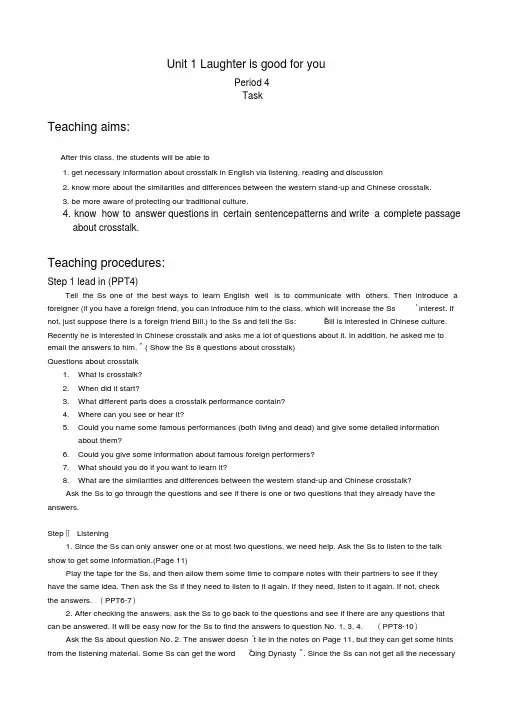
Unit 1 Laughter is good for youPeriod 4TaskTeaching aims:After this class, the students will be able to1. get necessary information about crosstalk in English via listening, reading and discussion2. know more about the similarities and differences between the western stand-up and Chinese crosstalk.3. be more aware of protecting our traditional culture.4. know how to answer questions in certain sentence p atterns and write a complete passageabout crosstalk.Teaching procedures:Step 1 lead in (PPT4)Tell the Ss one of the best ways to learn English well is to communicate with others. Then introduce a foreigner (if you have a foreign friend, you can introduce him to the class, which will increase the Ss’ interest. If not, just suppose there is a foreign friend Bill.) to the Ss and tell the Ss: “Bill is interested in Chinese culture. Recently he is interested in Chinese crosstalk and asks me a lot of questions about it. In addition, he asked me to email the answers to him.” ( Show the Ss 8 questions about crosstalk)Questions about crosstalk1.What is crosstalk?2.When did it start?3.What different parts does a crosstalk performance contain?4.Where can you see or hear it?5.Could you name some famous performances (both living and dead) and give some detailed informationabout them?6.Could you give some information about famous foreign performers?7.What should you do if you want to learn it?8.What are the similarities and differences between the western stand-up and Chinese crosstalk?Ask the Ss to go through the questions and see if there is one or two questions that they already have the answers.StepⅡListening1. Since the Ss can only answer one or at most two questions, we need help. Ask the Ss to listen to the talk show to get some information.(Page 11)Play the tape for the Ss, and then allow them some time to compare notes with their partners to see if theyhave the same idea. Then ask the Ss if they need to listen to it again. If they need, listen to it again. If not, checkthe answers. (PPT6-7)2. After checking the answers, ask the Ss to go back to the questions and see if there are any questions thatcan be answered. It will be easy now for the Ss to find the answers to question No. 1, 3, 4. (PPT8-10)Ask the Ss about question No. 2. The answer doesn’t lie in the notes on Page 11, but they can get some hints from the listening material. Some Ss can get the word “Qing Dynasty”. Since the Ss can not get all the necessaryinformation, give the Ss some key words and ask them to make up sentences about the history of crosstalk. Thekey words are: “Qing Dynasty, 150 years, the first crosstalk performer, Zhu Shaowen, Beijing”, then we can get “Crosstalk began in Beijing during the Qing Dynasty, over 150 years ago. The first crosstalk performer is calledZhu Shaowen and he started such a comedy form in Beijing.”(PPT11)3. Ask the Ss if there is any other question that can be answered. That will be question No. 7. It is not difficult for the Ss—They must understand the Chinese language and Chinese culture to enjoy crosstalk.Step III ReadingThe teacher may say to the Ss: “So if you want to learn crosstalk, you have to learn the language, but if you want to become a crosstalk comedian, is it enough to learn the Chinese language? What else do you need to do if you want to become a crosstalk performer?”1. Ask the Ss to read the passage on Page 11. Ask the Ss to find the three stages to become a crosstalk performer. (PPT15)(1) Have an interest in it;(2) Listen to and copy the traditional pieces of crosstalk;(3) Create crosstalk dialogues in pairs.From the three stages, we can conclude that besides language we also need “interest”, “practice/hard work”and “creativity”.(Ask the Ss to summarize it )2. Ask the Ss to go back to the questions and see if there is any more questions that can be answered.(PPT13-14)The Ss will find that question No. 5 and 6 can be answered. After each question, allow the Ss a chance to enjoy a short video about foreign performers and Ma Sanli. After the Ss enjoyed the crosstalk by Ma Sanli. Give them some information about Ma Sanli: “Ma Sanli was born in 1914 and started to perform crosstalk in 1930, atthe age of 16. Actually he was from a famous crosstalk family. He talked about small things happening in ourdaily life, so he was very popular among common people.” (The teacher can choose another performer according to his/her own interest.)Ask the Ss about their favorite crosstalk performer. Usually the Ss can only name their favorite comedian, so ask the Ss to collect information about their favorite performers and add the information to the email.3. After question 6, the teacher can show the Ss a video of the foreign performers to add to the interest.(It depends.)Step IV DiscussionTell the Ss: “Now we have only question No. 8 left, and we cannot get any information from the listeningand reading. Fortunately, we talked about “stand-up”in the reading part of this unit, and we have talked a lot about crosstalk today, so now it is your turn to come up with something about this question.”1. Allow the Ss around 5 minutes to discuss in groups of four and then collect their opinions. (During thispart, the teacher should give some help according to the Ss’ reaction.)Similarities: (1) The comedians are right in front of the audience, and communicate with the audience andamuse the audience;(2) The comedians will use different skills to makes jokes;(3) The comedians try to reveal something about lifeDifferences: (1)Stand-up-- Only involves one comedian; Crosstalk—Involves one, two, three or more people;(2) Stand-up---Involves more improvising; Crosstalk—is more fixed.(The similarity like “they are both comedies and about telling jokes” and the difference like “the languagesare different, one is in English, the other is in Chinese” are obvious, and can be dealt with orally.)Step ⅤComposition1.Ask the Ss: “How can we put all the sentences into a whole passage? Can we just put the answers togetherone by one?”2.Guide the Ss to use certain sentence patterns to organize their language.You wanted to know …Since you asked about …I know you need/want/would like information about …You asked me about …Regarding your question about …In answer to/ In reply to/ In response to your question about …Make a conclusion that when you answer a question, you have to mention it. Then the reader will be clearwhich question you are talking about.3.Give the Ss example sentences to make sure they know how to do it.(1) In reference to your question about famous performers, I’d like to say something about Ding GuangHe is …(2) You wanted to know what different parts a crosstalk performance contains, and I would say it involvestalking, imitating, singing and telling jokes.4. PracticeAsk the Ss to choose one or two questions to answer, using the sentence patterns.Step ⅥWritingWrite an e-mail to the foreigner, and you should include in your e-mail:1.The answers to questions 1,2,3 and 5;2.Add the information you get after class about your favorite crosstalk performer;3.Choose another 2 questions to answer.If possible, choose the emails of one or two students’ who finished early to read to the class. Ask other Ss to givecomments.Step ⅦLanguage study1.Then they move on to creating crosstalk dialogues with him.然后他们接下去和他一起创作相声对话。
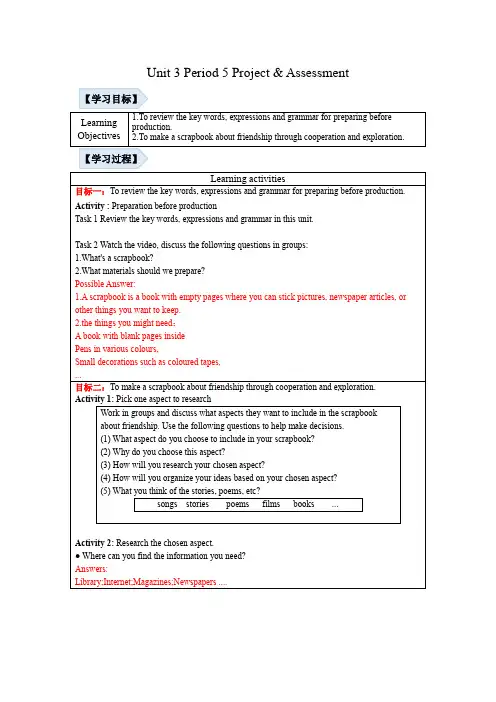
Unit 3 Period 5 Project & Assessment Learning Objectives 1.To review the key words, expressions and grammar for preparing beforeproduction. 2.To make a scrapbook about friendship through cooperation and exploration.Learning activities目标一:To review the key words, expressions and grammar for preparing before production. Activity : Preparation before productionTask 1 Review the key words, expressions and grammar in this unit.Task 2 Watch the video, discuss the following questions in groups:1.What's a scrapbook?2.What materials should we prepare?Possible Answer:1.A scrapbook is a book with empty pages where you can stick pictures, newspaper articles, or other things you want to keep.2.the things you might need :A book with blank pages insidePens in various colours,Small decorations such as coloured tapes,...目标二:To make a scrapbook about friendship through cooperation and exploration. Activity 1: Pick one aspect to researchWork in groups and discuss what aspects they want to include in the scrapbook about friendship. Use the following questions to help make decisions.(1) What aspect do you choose to include in your scrapbook?(2) Why do you choose this aspect?(3) How will you research your chosen aspect?(4) How will you organize your ideas based on your chosen aspect?(5) What you think of the stories, poems, etc?songs stories poems films books ...Activity 2: Research the chosen aspect.● Where can you find the information you need?Answers:Library;Internet;Magazines;Newspapers ....【学习目标】 【学习过程】When searching for information from different sources, remember to:check the date of the information you find, whether printed or online;check the source of the information you find. Generally speaking,information from official sources can be trusted.Activity 3: Summarize what can be presented on the page.Answers:(1)Supporting information/evidence(2)Your ments(3)Illustrations/picturesActivity 4: Think carefully about the layout. Put together all the information to finish the draft of the scrapbook. Then they should proofread the draft to make sure there are no mistakes. When the scrapbook page is finished, each group member should go through it carefully and give suggestions on how to improve it.Activity 5: Present the scrapbook's page to the whole class by talking about their chosen aspect. At the end of each presentation, other groups should ask questions about it or put forward suggestions.Activity 6: Evaluate the work of this project. Then the whole class vote on which scrapbook page is the best.Activity 7: Polish the scrapbook pages and put all the pages together to make a plete scrapbook. Sample Presentation:Summary:AssessmentA In pairs, rank your performance level in the following areas from 1 to 5. Write down your own assessment in the column "Me"and ask your partner to write down his/her assessment of your performance in the column "Partner".B If improvement is required for some of the areas above, make an action plan.。
2019外研版选择性必修三教学设计Unit 1 Face valuesProject板块教学设计(此部分教师可根据教学实际酌情调整。
)课型Speaking主题语境对“美”的理解内容分析本板块要求学生将小说节选改编成戏剧并将其表演出来。
通过共同改编和表演戏剧的过程,帮助学生深入了解外表和内心的矛盾冲突,树立正确的人生观和价值观。
学生在教师的指导下,综合运用单元所学知识,开展自主合作,有效完成开放型任务,进一步探索外表和内心的关系这一主题语境,发展综合语言运用能力。
教学目标 1. 学生通过阅读和选择自己想要改编的小说,培养识别、分析和整合信息的能力;2. 学生了解和掌握戏剧的特点,能够从小说中选择合适的内容自主进行改编;3. 学生通过合作表演,加深对单元主题意义的理解,树立的正确的审美观,培养积极向上的人生态度。
教学重点 1. 引导学生利用单元所学,能够从小说中选择合适的内容自主进行改编;2. 确定分组,完善小组内分工,为短剧表演做好准备。
教学难点引导学生了解自己特长,分工合作。
教学策略任务型教学法Teaching Procedures Purposescontents Teacher’s activity Students’ activityInvestigate 1.T asks Ss to choose abook that they haveenjoyed reading.2.T asks Ss to select anexcerpt which they feeleffectively contrasts aperson’s physicalappearance with theirpersonality and inneremotions. 1.Ss choose a book thatthey have enjoyedreading.2.Ss select an excerptwhich they feeleffectively contrasts aperson’s physicalappearance with theirpersonality and inneremotions.Prepare for the contentof the short play.Plan 1.T asks Ss to work ingroups, discussing andvoting for the excerptthat they would like toadapt.2.T guides Ss to talkabout how they mightadapt the excerpt into ashort play. 1.Ss work in groups,discussing and votingfor the excerpt that theywould like to adapt.2.Ss talk about howthey might adapt theexcerpt into a short play.Decide on the excerptto be adapted.Create 1.T guides Ss to writethe play.2.T guides Ss to assignroles.3.T asks Ss to rehearsethe play. 1.Ss write the play.2.Ss assign roles.3.Ss rehearse the play.Assign roles andpractise.Present 1.T invites Ss toperform the play.2.T asks Ss to vote for 1.Ss perform the play.2.Ss vote for the bestplay, best script, best setPractise skills inperforming a play.the best play, best script, best set and costume design, and best actor / actress. and costume design, and best actor/ actress.。
M3 U3 LanguageTeaching notes for Task & ProjectTaskLanguage focus1. declare vt. 正式宣布,宣称,郑重地说,声明declaration n.【用法提示】(1) declare sth. 宣布,申报(2) declare sb./sth. to be 宣布某人/某事为……(3) declare +that-clause 宣布,宣称……(4) declared for/against 声明支持/反对【考点训练】(1) He declared that he was innocent. 他郑重声明他是清白的。
(2) They declared him (to be) the winner. 他们宣布他为获胜者。
(3) Hearing the 2008 Olympic Games ______, all the people in Beijing National Stadium burstinto cheers.A. declared to be openedB. declaring to be openedC. declared openD. to be declared open2. in memory of = to the memory of 为了纪念She set up a charitable fund in memory of her father.类似结构:in place of/in favour of/in need of/in search of/in charge of/in control of【联想拓展】memorial n. 纪念碑,纪念馆a memorial to sb./sth. 为纪念……而立的纪念碑【考点训练】(1) This metal statue was built in memory of a famous scholar (为了纪念一位著名学者).(2) They raised a memorial to the poet (为那位诗人立了一块纪念碑).ProjectLanguage focus1. (Page 58 Line 2)When asked how a statue from distant Greece could have appeared in China, researchers explained that no doubt this was a result of Alexander the Great’s influence.【用法提示】情态动词+ have done可表示对过去的推测:could have done sth. 可能已做过某事can’t/couldn’t have done sth. 不可能做过某事Can/Could … have done sth.? ……可能做了……吗?may/might (not) have done sth. 可能(没)做过某事must have done sth. 一定做过某事【考点训练】(1) Your eyes are so red. You can’t have slept well (不可能睡得好) last night.(2) My MP4 player isn’t in my bag. Where can I have put it? (我可能把它放哪儿了呢?)(3) My book, The house of Hades, is missing. Who could have taken it? (谁可能拿了它呢?)(4) The children must have got lost (一定迷路了) in the woods; otherwise, they would have beenat the lakeside camp as scheduled.(5) —I left my handbag on the train, but luckily someone gave it to a railway official.—How unbelievable to get it back! I mean, someone ______ it.A. will have stolenB. might have stolenC. should have stolenD. must have stolen2. (Page 58 Line 15) By the age of thirty, he had already occupied more land than anyone before, and it seemed that more glory was waiting ahead of him.▶ahead adv. (时间、空间)在前面;提前,预先;领先【考点训练】(1) Walk straight ahead (径直朝前走) until you reach a crossroads.(2) The party was planned weeks ahead (提前几周).【联想拓展】ahead of sb./sth.(1) (空间)在……前面在我们面前坐落着一座古老的庙宇。
中考19专题—阅读理解(教师版)芝麻开门Rory: Time me. I'm going to do this cube puzzle.Rory: Are you timing me?Stan: March 6, 2009. Go.(批注:欣赏小漫画,猜猜单词的含义:time: 计时;cube: 立方体puzzle: 难题cube puzzle: 【魔方】知己知彼近三年中考真题分析:用兵如神考点一: 细节理解题【典型例题1】【2018 北京中考A】47. How many popular articles are there in the magazine?A. 2B. 3C. 4D.548. Which article is about saving money?A. Ice cream and banking.B. Black sheep and Uncle Bob.C. Relation between you and food.D. Films that aren’t really about Canada.49. What is Black sheep and Uncle Bob about?A. American films.B. Family stories.C. Food.D. Banking.【答案】47.C 48.A 49.B【考点精析】47. 该题是一道细节题。
图表的标题"Popular Articles in the Magazine",意思是"杂志中受欢迎的文章",一共有四篇文章,所以也可以得知该题的答案为C。
What does Ping! hope to achieve?It would be great if Ping !helped find a new Olympic table tennis star but what Ping! really hopes to achieve is just to get people playing and having fun together."Putting a ping pong table on the street gives people a chance to connect with other people," said Meera Sodha, Ping! Project Manager.One of the towns that took part in the project was Hull, a city in England. Forty-five tables were put into the city. Jakob Adamski, an ESOL student learning. English, said, "I really enjoyed playing table tennis in the park. It was also a good way for me to practise my English and meet people." 50. When did the Ping! project start?A. Last summer.B. Last winter.C. In 2010.D. In 2012. 【答案】50.C 【考点精析】50. 本题属于细节题。
“项目化阅读”在初中英语真实阅读实验中的实践与思考赵欢欢摘要:我国初中英语的传统教学方式以教师单方向输出知识为主,在阅读训练方面,也仅为布置阅读-做题-讲解题目的套路。
但是阅读应仅以完成题目为目的的阅读方式极易令学生感到枯燥,不愿意完成。
“项目化阅读”能够改变单一枯燥的英语阅读方式,激发学生阅读兴趣。
关键词:项目化阅读初中英语实践1.项目化阅读的定义项目化学习是指针对某项目主题,通过一系列任务与活动完成的开放性研究。
在此基础上产生的项目化作业(project)已经成为国内外众多学校基础教育中布置作业的一大趋势。
在朗文词典中,对于项目的解释译为需要学生自行研究并给出研究结果的教育任务。
将项目化作业定向应用于英文阅读锻炼的方面即为项目化阅读。
项目化阅读的实施需要教师依据学生的兴趣爱好和阅读水平,确定某一主题、内容及形式,学生通过自行设计方案,以一定计划完成英语阅读。
2.“项目化阅读”在初中英语真实阅读实验中的实践2.1项目内容项目化阅读中教师提出的项目内容应做到全面,能够满足学生多元化发展,而不仅局限于词汇、语法等基础英语知识。
具体应包括以下内容:2.1.1基础信息学生在阅读过程中应以日志形式记录下阅读材料的基础信息,包括书名、作者、阅读时间、字数等。
同时应收集整理书中的好词好句,新词生词等,关注词汇在具体情景下的应用方式,有助于记住并理解词汇的意思。
2.1.2个人思路学生在阅读完成后,应对文章内容进行整理,用自己的话重新叙述故事的脉络、对故事中的人物进行自己的评价、个人的其他原创观点等。
该项目内容属于项目化阅读中具有开放性的一部分,能够确保学生完成阅读后才能回答问题,且通过此类问题的答案能够观察出学生的个体差异性。
2.1.3读后感悟教师应要求学生记录下通过阅读该材料,获得了何种感悟。
例如,在外研版七年级下册英语课本module4:Life in the future部分,学生可以发挥想象力,在读后感悟部分写下自己对于未来世界的独特想法,如脑电波传送、瞬移等异想天开的想法。
Unit 2 Project
iSth 匚
—Reading comprehension
Before class, you'd better:
1.read the new words from ’Tange" to "decade" on page 39, pay attention to their pronunciations and Chinese meanings, and try to learn them by your hearts.
2.read the two passages on page 38-39 and grasp the main ideas of them.
3.read the two passages and answer complete the following exercises・
as for protecting the Yangtze River
探Read the whole text and try to understand the meaning of the paragragh・
Paral The health of the Yangtze River has raised concern・
Para2 Many people have recognized the importance of protecting the Yangtze River and organizations and projects have been set up to do this・
Para3 Two special government projects are under way to protect the river. One is a water and soil preservation project.
Para4 The second project is nature reserves for white-flag dolphins.
Para5 The situation on the Yangtze River is improving・
探Careful Reading and answer the following questions・
1What does the Green River Organization do?
It educates people on the importance of the protecting the Yangtze Rive匚
2What problems do the two government projects focus on?
They focus on water and soil conservation and protecting white-flag dolphins along the Yangtze River.
3What did farmers have to do under the water and soil conservation project?
They had to replace their crops with trees or grass.
4What does the second project include?
The second project includes nature reserves for white-flag dolphins.
模块四Unit 2 Project阅读理解部分第1页(共3页)
Understand the structure of the text
探Discussion
模块四Unit 2导学宰
Do you think the environmental situation of the Yangtze River is getting better? VVhv?
What else can we do to protect the Yangtze River?
As for Climate change and a low-carbon life.
探Have students focus on the second article Climate change and a low-carbon life and ask the following questions.
1What will you think about when you see the title?
2Can we predict what the article will talk about according to the title?
3What is the relationship between climate change and the low-carbon life?
4What du you think causes climate change? Do you think that your way of life can change the climate?
5Can you give some examples to show what kind of life a low-carbon life is?
探Haw students read the article and find out what it is about. Write the following on the blackboard: Problem: More and more carbon dioxide has been put into the atmosphere, which has brought about climate change・
Causes: Breathing of animals and humans; other human activities; cars and other vehicles; electrical power plants
模块四Unit 2 Project阅读理解部分第2页(共3页)
Solutions to the problem: walk or use a bike when possible; use as little energy as possible; recycle as much as possible; plant trees
^Collect students' answers and encourage them to find more about how to live a low-carbon life.
模块四Unit 2 Project阅读理解部分第3页(共3页)。